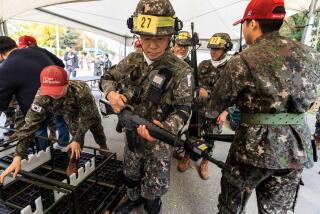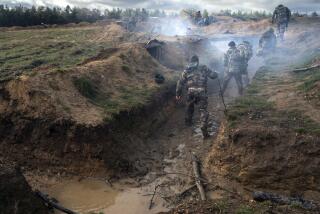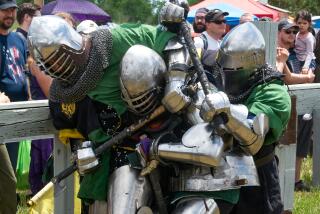A Graduate School for Warriors : Military: Colonels prepare for combat by sitting at a computer in Kansas. They have an illustrious list of alumni to follow.
LEAVENWORTH, Kan. — Picture a desert battlefield at night: The artillery thunders, personnel carriers roll past, explosions flash in the darkness.
Lt. Col. Keith Dickinson, commanding the 1st Battalion, 92nd Infantry, orders his troops to advance. He radios Lt. Col. C. L. Webb, 1st Battalion, 52nd Field Artillery, to fire on an enemy gun emplacement blocking the way.
The artillery, firing from the rear, can’t see where the shell lands. Dickinson can tell it has missed. He radios Webb again, with new coordinates. This time, the shell is on target, knocking out the enemy. The infantry advances on the objective.
Fortunately, today there will be no live casualties on either side. This battle is being fought not in the field, not in the sands of Iraq, but in a computer program at Ft. Leavenworth, Kan., the home of the U.S. Army Command and General Staff College.
The nine lieutenant colonels and colonels in this simulation are winding up a two-week tactical commanders development course. They have been selected through rigorous competition for a command assignment, which they now are learning how to perform. “If a guy’s in the dirty boot business (involved in ground combat), he’ll come our way,” said Col. Daniel F. Butler, director of the program.
In their early years as lieutenants and captains, officers go to forts nationwide to learn techniques in areas such as artillery, infantry, armor and combat engineering. By the time they reach their ninth year of service, they are ready to put the pieces together.
That’s when they come to Leavenworth. Founded in 1881 by Gen. William Tecumseh Sherman, the college is the Army’s senior tactical school.
Its roster of star students is the stuff of legend: Gens. Douglas MacArthur, Omar Bradley, Maxwell Taylor and former President Dwight D. Eisenhower. More recent household names include Colin L. Powell, chairman of the Joint Chiefs, Class of ‘68, and H. Norman Schwarzkopf, commander of Operation Desert Storm, Class of ’69.
The main program, the command and general staff officer course, is for majors, at around the 13th year. It lasts 40 weeks, costs roughly $50,000 per student and enjoys a worldwide reputation.
Besides 1,025 Army officers, the 1990-91 student body boasts 50 Air Force, 20 Marine Corps and 10 Navy enrollees. The program also has 93 students from 63 foreign countries, including contingents from Turkey, Bahrain, Saudi Arabia, Egypt and Jordan.
Leavenworth’s mission is combined arms--that is, learning to assemble all the elements of an armed conflict in the right proportions and proper order to attain victory.
The curriculum, long geared to war in Europe, is being adapted to reflect the Army’s current engagement. Instead of facing a Soviet motorized rifle division, simulation students are dealing with a “Samaran” threat, loosely resembling Iraqi force structure and doctrine.
Maj. Jim O’Brien, a combat engineering officer, is designing a scenario to allow captains to plan attacks in a desert. Students must find a way to breach a vast array of defensive obstacles. The curriculum had been weak in that area. “It was not the kind of thing we expected to encounter,” O’Brien said, referring to Iraqi defenses around Kuwait.
Col. Tom Schmidt, another program director, said: “The depth and intensity of those obstacles--7-, 8-miles of minefields and trenches--are much greater than we have taught at any of our schools. That’s what we’re seeing (in the Persian Gulf). We haven’t been training for that.”
But the Army does feel better prepared for desert warfare. Since 1985, it has rotated brigades through training at Ft. Irwin in the Mojave Desert. The computer simulations are played on a digitized representation of the terrain there. Last week, the brigade fought a reconnaissance battle across a piece of land the size of Rhode Island.
The commanders tried to size up enemy defenses and deployment, similar to skirmishes that have been fought between U.S. and Iraqi forces along the Saudi border in the last several days.
The main simulated engagement, which will be fought the next morning, will last only two hours in “real time.”
In the classroom, the brigade commander and two staff officers update a map showing their battle plan on acetate overlays. No participant has a complete understanding of what is happening on the battlefield; they rely on radio communications from other officers around the room to fill them in.
Each of four battalion commanders sits at an oversized computer screen, giving directions to a keyboard operator who executes the order. The display shows a contour map of the battlefield. U.S. forces are blue markers; the enemy is red. The software replicates the soldier’s weapon and its range. When a shot is fired, the computer gives a mathematical result based on the probability of hitting the target, and if hit, of killing it.
“It plays a three-dimensional piece of ground,” says Lt. Col. Bennett Dickson, an instructor. “If you’re in a hole you can’t be seen, but you also can’t shoot.”
Of course, the enemy can do everything the student can, based on realistic capabilities. In an anteroom, two balding civilians--retired military experts themselves, now working as consultants--sit at computer screens, plotting tactics of the Red forces.
The software program is fully interactive. If the Reds play better than the command students, the U.S. forces can be wiped out.
More to Read
Sign up for Essential California
The most important California stories and recommendations in your inbox every morning.
You may occasionally receive promotional content from the Los Angeles Times.










